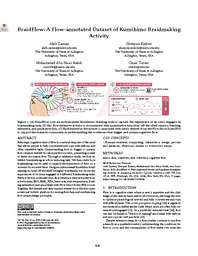
ATTENTION: The works hosted here are being migrated to a new repository that will consolidate resources, improve discoverability, and better show UTA's research impact on the global community. We will update authors as the migration progresses. Please see MavMatrix for more information.
Show simple item record
| dc.contributor.author | Zaman, Akib | |
| dc.contributor.author | Rakib, Mohammad Abu Nasir | |
| dc.contributor.author | Endow, Shreyosi | |
| dc.contributor.author | Torres, Cesar | |
| dc.date.accessioned | 2023-07-26T20:29:34Z | |
| dc.date.available | 2023-07-26T20:29:34Z | |
| dc.date.issued | 2023-07-14 | |
| dc.identifier.uri | http://hdl.handle.net/10106/31625 | |
| dc.description.abstract | Entering a cognitive state of fow is a natural response of the mind
that allows people to fully concentrate and cope with tedious, and
often repetitive tasks. Understanding how to trigger or sustain
fow remains limited by retrospective surveys, presenting a need
to better document fow. Through a validation study, we frst establish braidmaking as a fow-inducing task. We then study how
braidmaking can be used to unpack the experience of fow on a
moment-by-moment basis. Using an instrumented Kumihimo braidmaking tool and of-the-shelf biosignal wristbands, we record the
experiences of 24 users engaged in 3 diferent braidmaking tasks.
Feature vectors motivated from fow literature were extracted from
activity data (IMU, EMG, EDA, heart rate, skin temperature, braiding telemetry) and annotated with Flow Short Scale (FSS) scores.
Together, this dataset and data-capture system form the frst openaccess and holistic platform for mining fow data and synthesizing
fow-aware design principles. | en_US |
| dc.language.iso | en_US | en_US |
| dc.publisher | ACM | en_US |
| dc.subject | sensor data; creativity; data collection; cognitive fow | en_US |
| dc.title | BraidFlow: A Flow-annotated Dataset of Kumihimo Braidmaking Activity | en_US |
| dc.type | Article | en_US |
Files in this item
- Name:
- 3563657.3596026.pdf
- Size:
- 19.69Mb
- Format:
- PDF
- Description:
- Journal Article
This item appears in the following Collection(s)
Show simple item record


